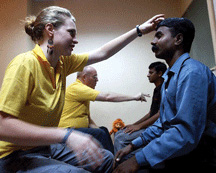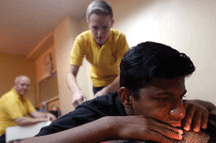Life
Tribal Instincts

Tom Cruise's faith discovers an Indian audience
| As she strolls down Dadabhai Naoroji Road in Mumbai, Aussie Marion Whitta gets a tap on the shoulder from a tall Indian fan. “I bought Dianetics (the first book of a post-modern faith called Scientology) in 1987 in Melbourne,” he says. He is in a yellow polo shirt inscribed with the Scientology logo on the back. He walks with her for about 50 paces, interrupting the conversation she is trying to have with friend. He recounts the moment he first encountered Scientology, never once wiping the loyal puppy-dog grin off his face.
Whitta, who is over 50 and has a smoker’s husky voice, is a leader of Scientology and a veteran at handling the Scientology fan base. She tells this reporter the gushing gratitude of the devout, “happens to us all the time.” The late L. Ron Hubbard founded Scientology in the 50s. Hubbard was investigated by U.S. government agencies for fraud and Russell Miller, who wrote an unofficial biography on Hubbard, described him as “one of the most successful and colorful confidence tricksters of the twentieth century.” Over the decades, Scientology has amassed numerous fans and controversies. Today, it is best identified as Tom Cruise’s religion.
To promote the ideas of Scientology in India, scores of its prophets, from countries like America, France and Australia, have landed in Mumbai to officially introduce their brand of fool-proof “science” of self-improvement. They haven’t set up an official church in Mumbai yet, but the Church of Scientology has operated in Delhi for some time. There are other Scientology branches or “missions” in Patiala, Mysore and Kolkata, where training is conducted. Scientologists count between 4,000 to 5,000 Indians as members, most of whom have been impressed by the all-souls-compatible philosophy of the religion – you don’t have to renounce an old faith to become a Scientologist. It works as a complimentary religion that supplements a person’s faith. As a religion, it “provides exact principles and practical technology for improving self-confidence, intelligence and ability,” according to its official book, What is Scientology, a 1000-page tome weighing 7 lbs. It’s basically a self-improvement scheme that allows people to “become more themselves,” says Whitta. But Scientologists don’t usually offer a direct understanding of what it is. Scientology trainer, Felix Lange, a boyish, blond man from Germany with innocent eyes says, “When I’m asked what it is, I usually ask the other person about himself, ask about what’s going on in his life and find out which issues he is dealing with. Scientology can help you with those, I say.” The core fundamentals of the ideologies put forth by Hubbard in Dianetics are derived not from divine inspiration, but from bits and pieces of religious texts and world study, stitched together by the former writer of science fiction novels. The four trainers and their leader, Whitta, who are in India to spread the word, have reached out to the Bombay Municipal Corporation staff (Mumbai’s version of city council), various branches of the fire brigade and Jai Hind College among other organizations. Scientology offers many courses, whose de scri ptions read like the wish-lists of people afflicted with a common problem known as “living life.” Everyday problems can be solved, like achieving new levels of practical life abilities, communication, concentration, stress-reduction, studying, etc. The Super Power course promises, “Twelve individual rundowns can put a person into fantastic shape unleashing the Super Power of a Thetan.” The New Life Rundown course will, “address the main block or the area of irrationality. It can bring a new start, a new viewpoint of sanity and rationality.” The first step in becoming a Scientologist is to read Dianetics, a book that includes the understatement: “This volume has made no effort to use resounding or thunderous phrases, frowning polysyllables or professorial detachment. When one is delivering answers which are simple, he need not make the communication any more difficult than is necessary to convey the ideas.”
The next step is to undergo “auditing,” a name given for one-on-one therapy sessions. Through working out negative memories from the past, one moves from a state of “pre-clear” to “clear” in about a year’s time with an investment of about Rs 14,000 ($350) to Rs 22,000 ($450), says Shalini Sharma of the Delhi centre. A pre-clear is someone who still has a “reactive mind,” someone who is sensitive to negative experiences and reacts accordingly. A clear is someone who no longer has the “reactive mind.” Next step is becoming an “operating Thetan,” one who invests much more to achieve “total freedom,” a state not unlike experiencing enlightenment. With “total freedom” an operating Thetan is “able to control himself and his environment, he becomes more powerful, stable and responsible,” according to Scientology’s texts. When the yellow uniformed disseminators of information aren’t flitting around town, headed to various training locales, they conduct training on themselves, and on drop-in groupies in a small windowless room in a nonde scri pt hotel in the Fort neighborhood of Mumbai. The room is also where the prophets are staying. People like 24-year-old Sonia Makwani are here through word-of-mouthreferral. She is the founder of NGO, Touch One Life, who has completed courses in holistic healing, has a master’s degree in clinical psychology and a doctorate in hypnotherapy. Then there are people who have accidentally fallen into Scientology, like the 24-year-old drop-out from the University of Pennsylvania who has moved back in with his parents in Colaba. He stumbled upon Scientology in Nariman Point one day when its apostles had set up a tent near the fire brigade. “I’ve stayed in the program this far only because nothing has driven me away,” he says with an American accent. Whitta had found Scientology after suffering through debilitating juvenile arthritis. When she was nine, she was walking with the help of a cane, and even moving in a wheel chair. She was in and out of the hospital until her mother finally tried Scientology. “All I know is it worked. Scientology worked for me. I walked in with a walking stick and I walked out without it.” The Dianetics book is replete with such stories of triumph. Scientologists also talk fondly of the peculiar, “silent birth” of Suri Cruise, the revered daughter of Katie Holmes and the most famous fan of Scientology, Tom Cruise. Scientologists believe that anything said around a person who is unconscious, whether from an accident, sickness or by the virtue of being in the birth canal, can negatively affect that person, by way of the power of suggestion. The claims of Scientology have long been contested by mainstream science. The French government has been in court battles for years over limiting the practice of Scientology in the country. It wanted to bring Scientology under the arm of legislation it had passed against “fraudulent abuse of a state of ignorance or weakness,” which is punishable with a maximum sentence of a three-year jail term. A Scientologist in that country was recently convicted of involuntary homicide for the death of a member who went into heavy debt from paying for Scientology courses and eventually committed suicide. The faith has also been investigated by the European International Police Organization (Interpol), the Internal Revenue Service (IRS) and the U.S Post Office. In Clearwater, Florida, a wrongful death case against the Church of Scientology for the death of Lisa McPherson, who died of pulmonary thrombosis while under its care, was settled out of court in 2004. The most contentious part of Scientology is that it considers homosexuality a perversion, an incendiary view today in the West. “The sexual pervert (and by this term Dianetics includes any and all forms of deviation like homosexuality, sexual sadism, etc.,) is actually quite ill physically…he is so far from normal and so extremely dangerous to society that the tolerance of perversion is as thoroughly bad for society as punishment for it.” Whitta says in a reassuring tone, “We know how to deal with it though.” Scientologists can audit a pre-clear to reduce the influence of homosexuality in a person. Of course, some argue that it’s Scientologists who need help. |
||||



You must be logged in to post a comment Login